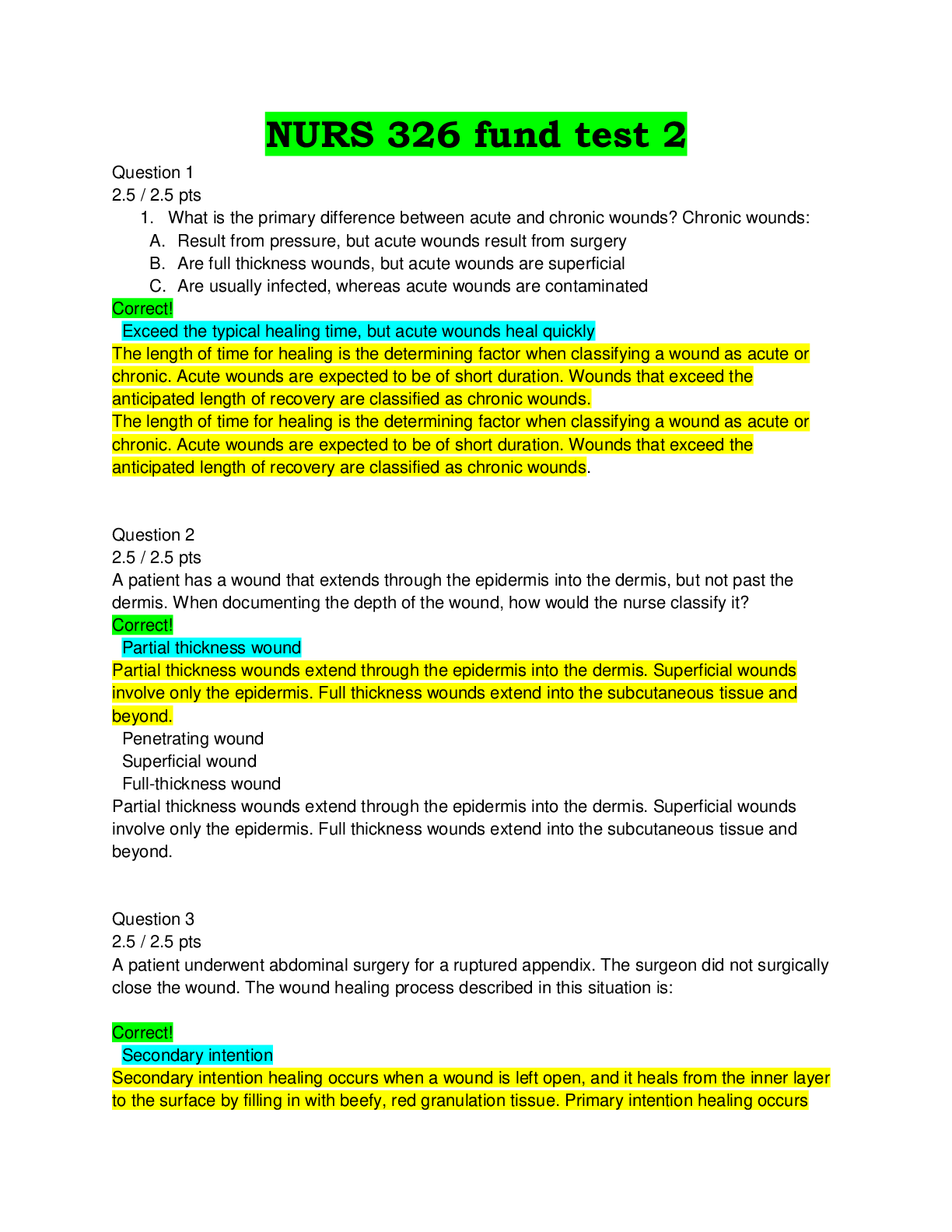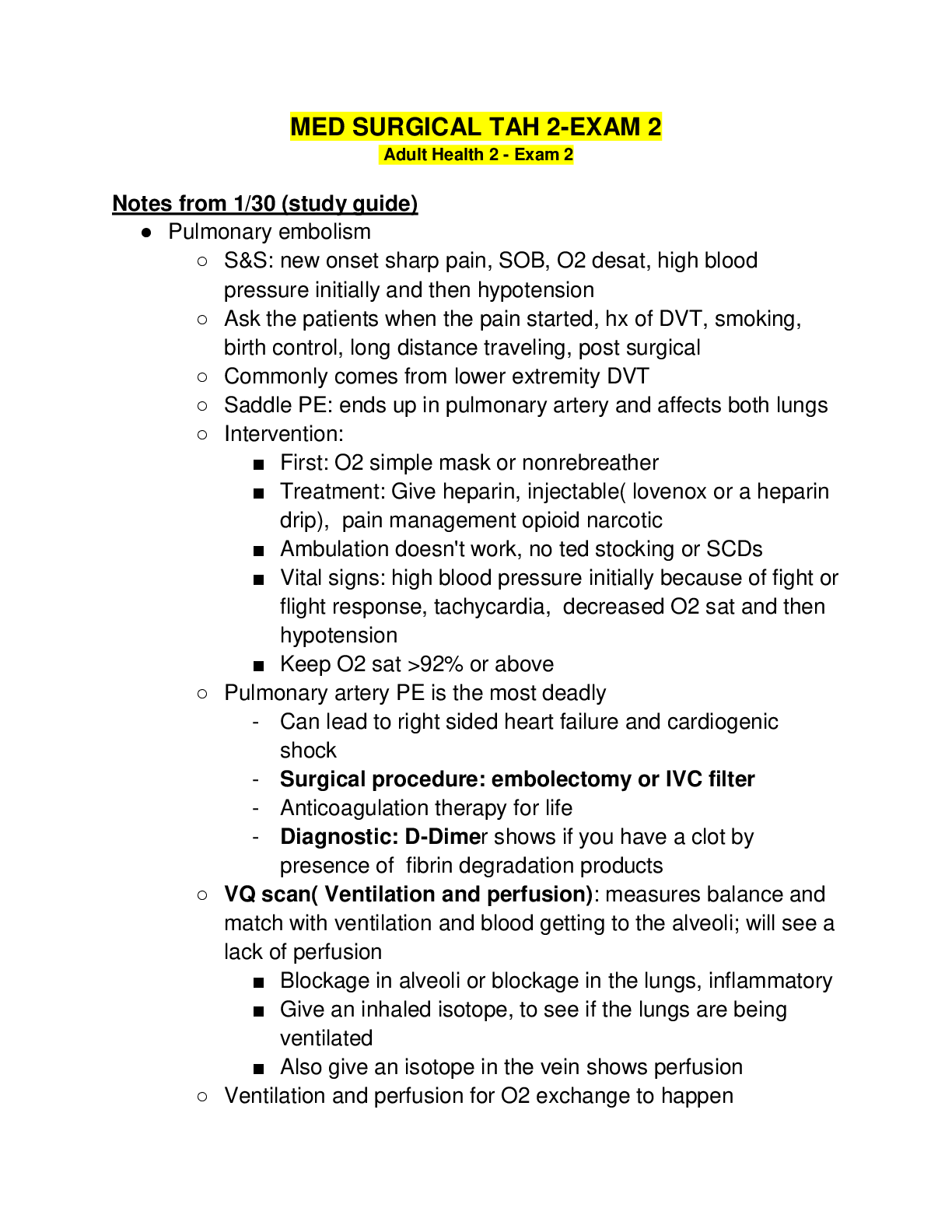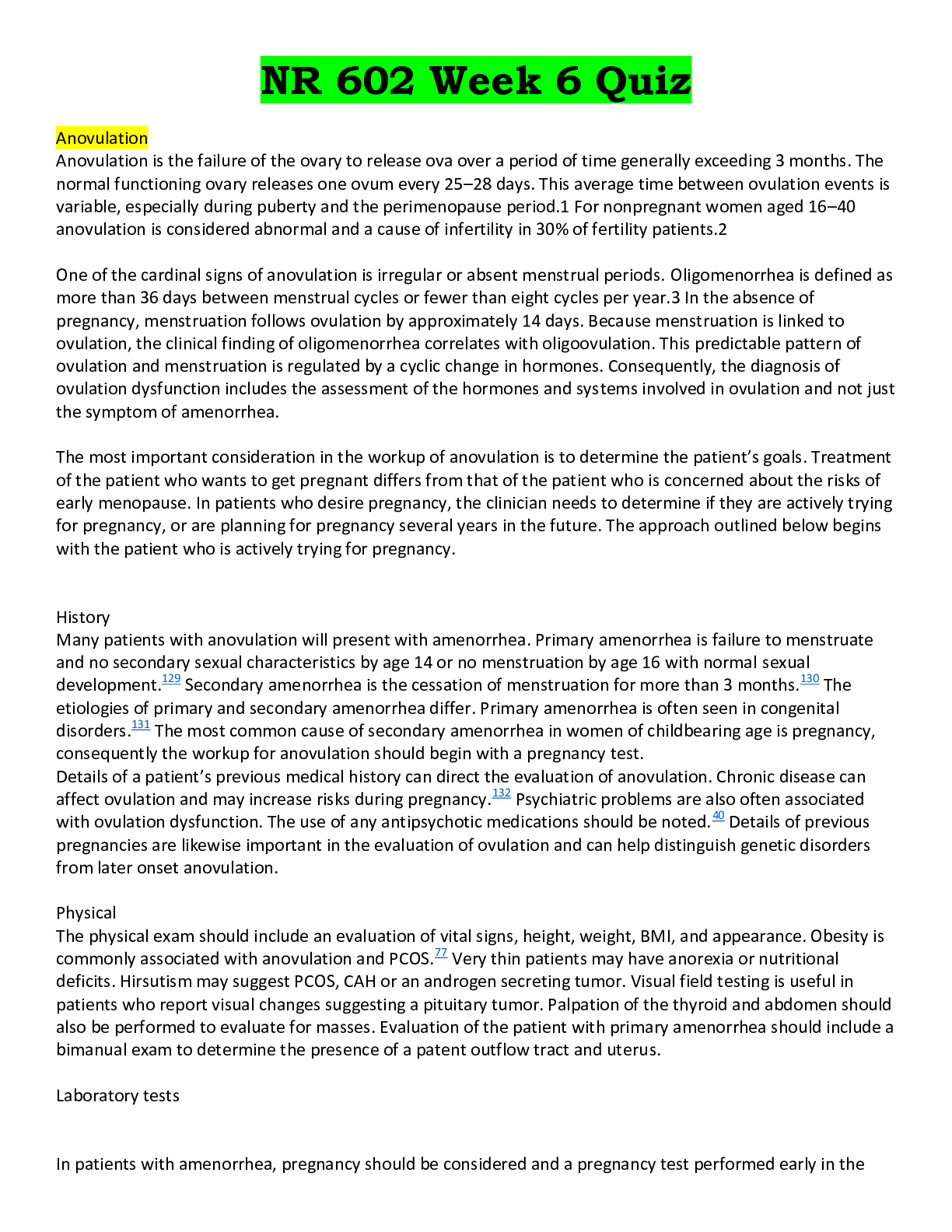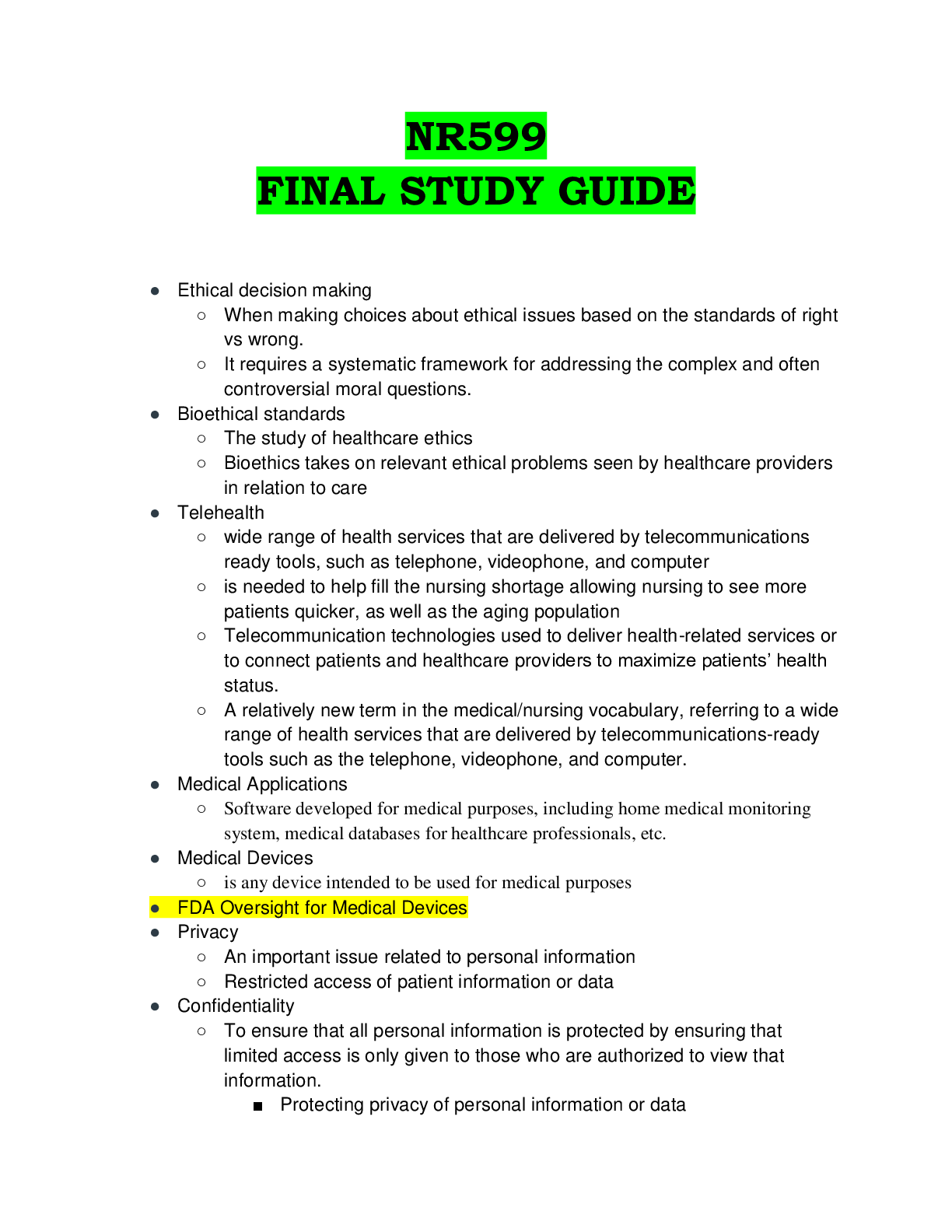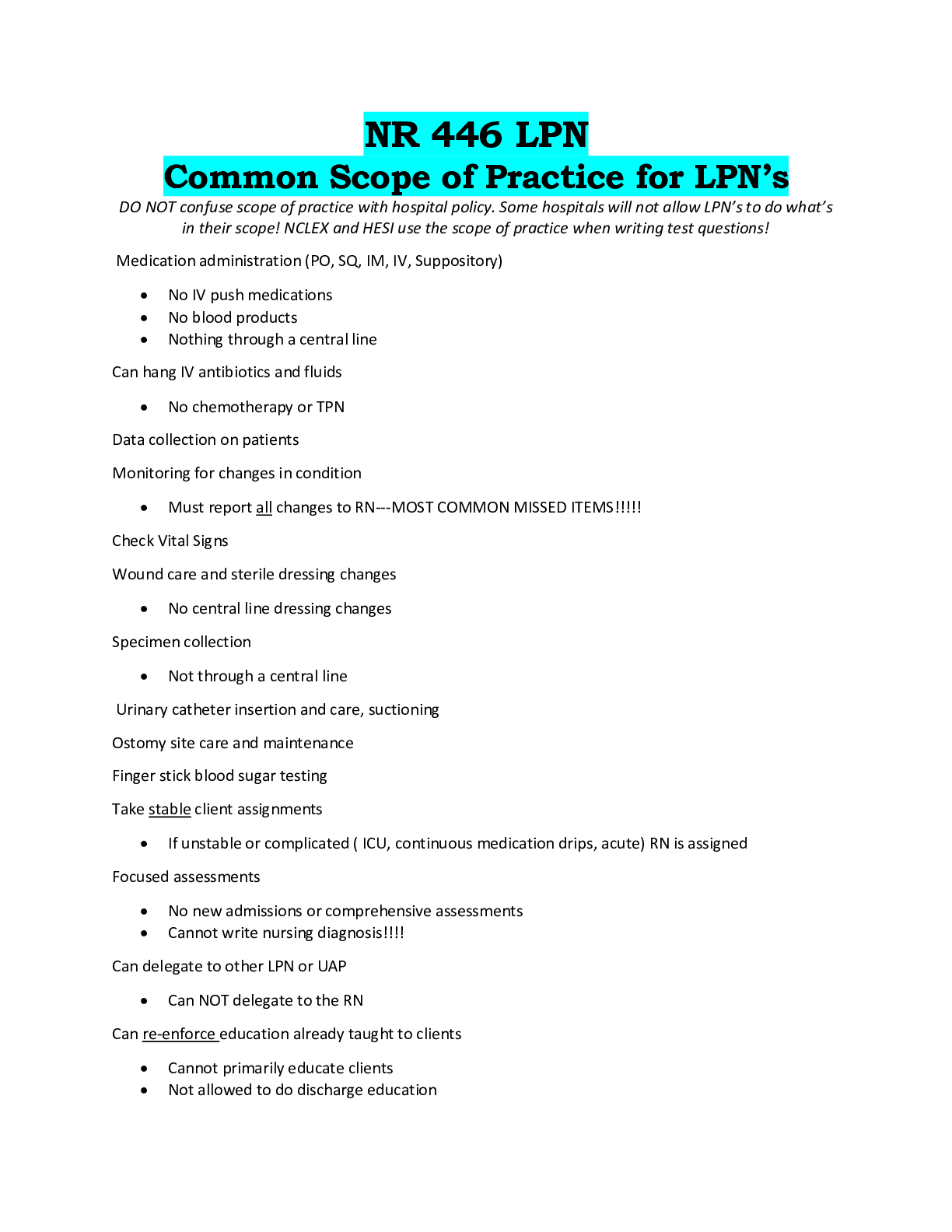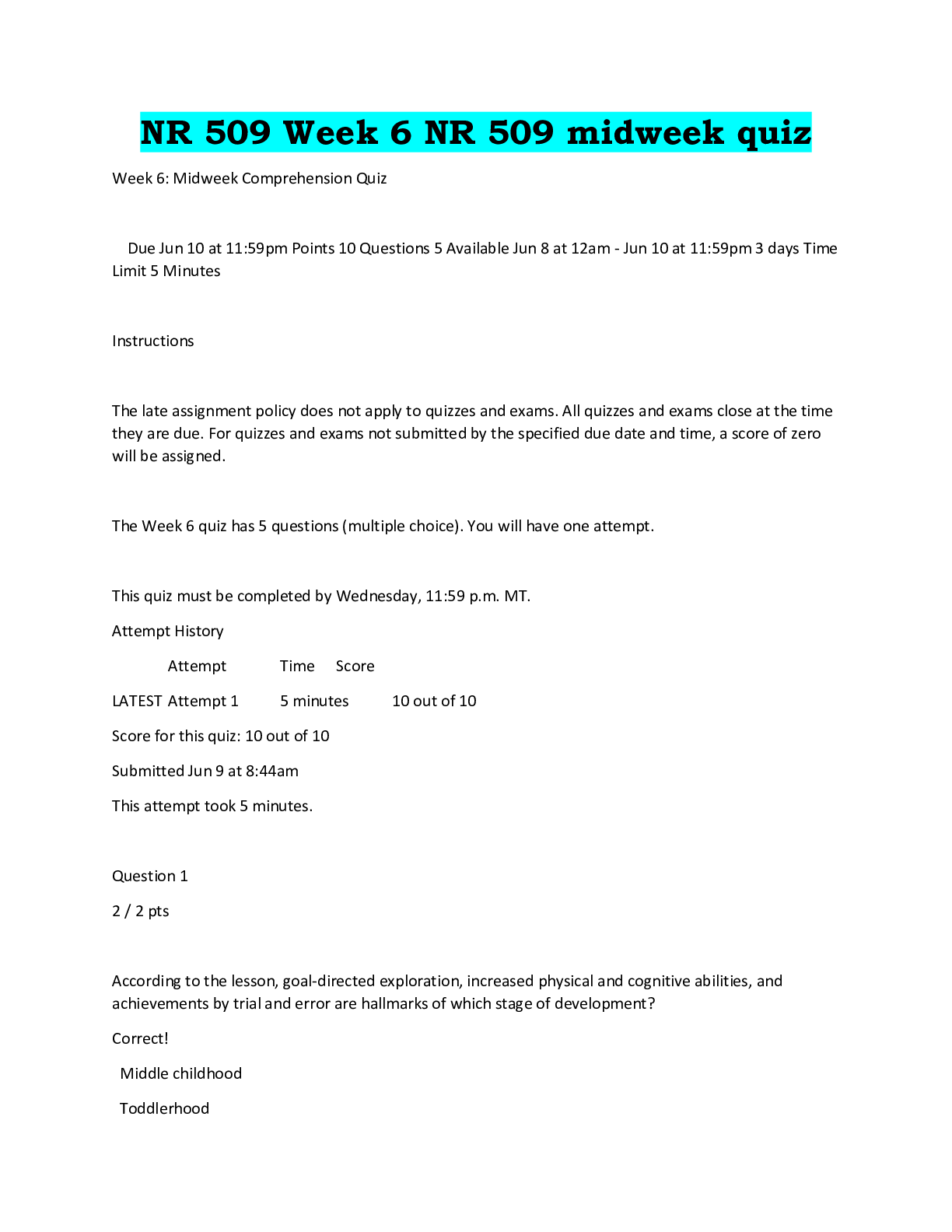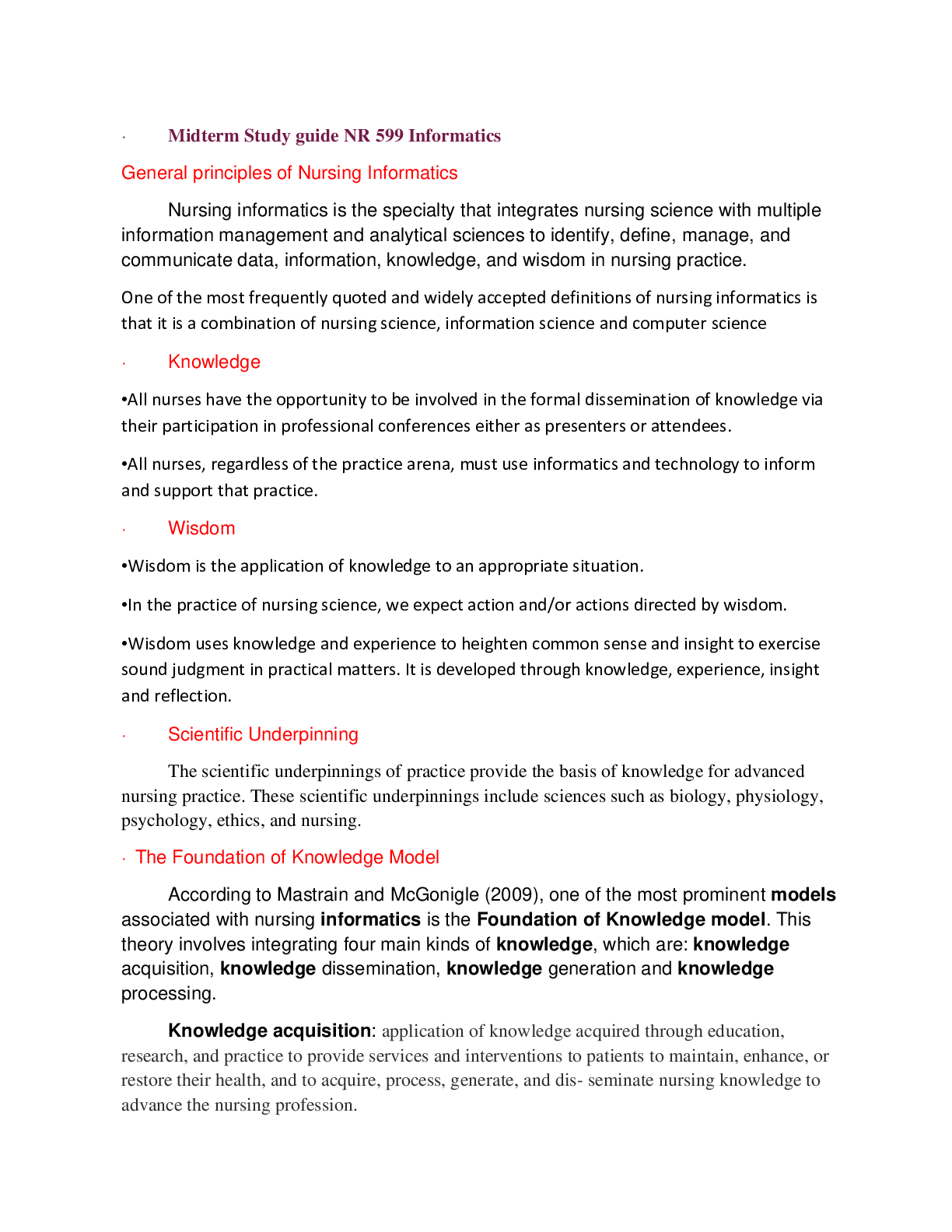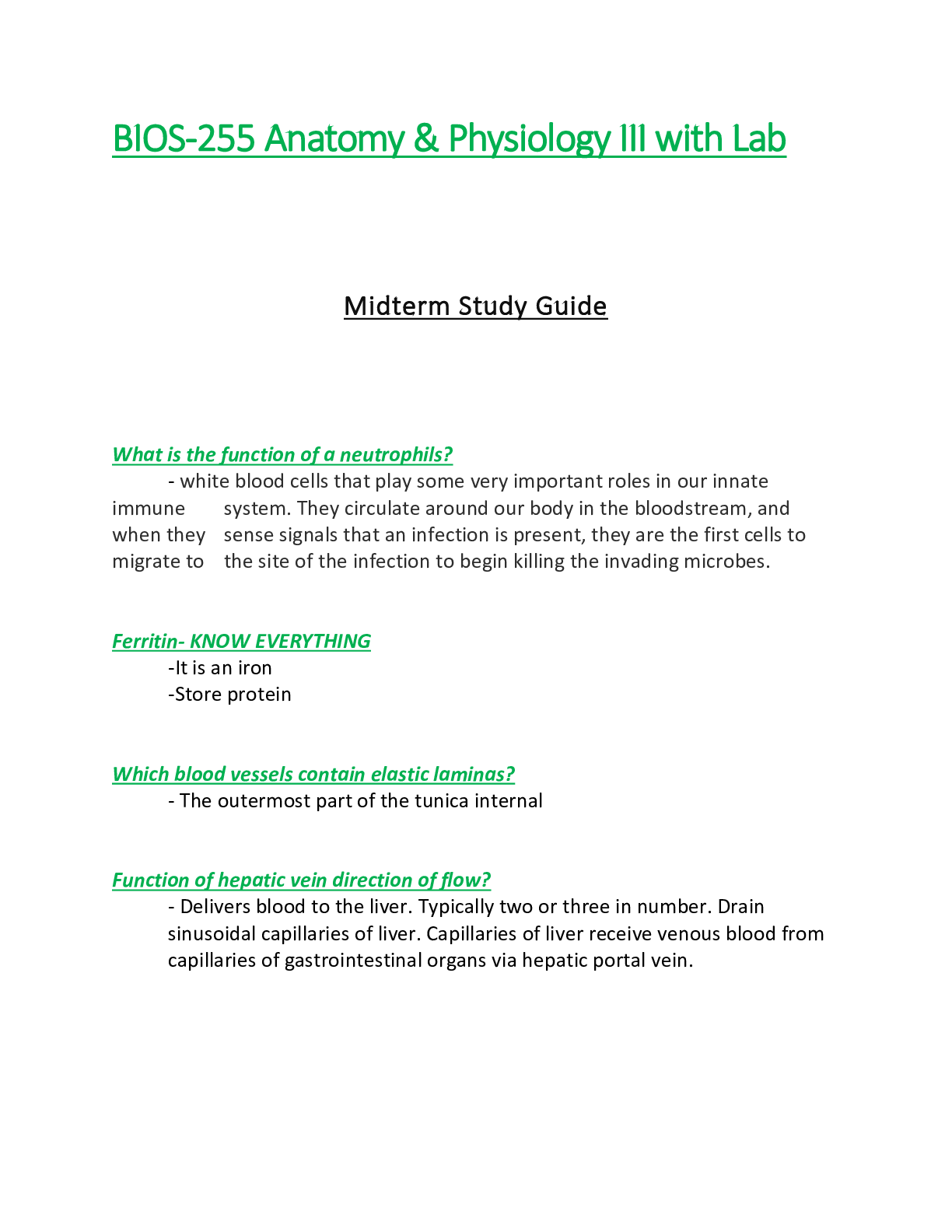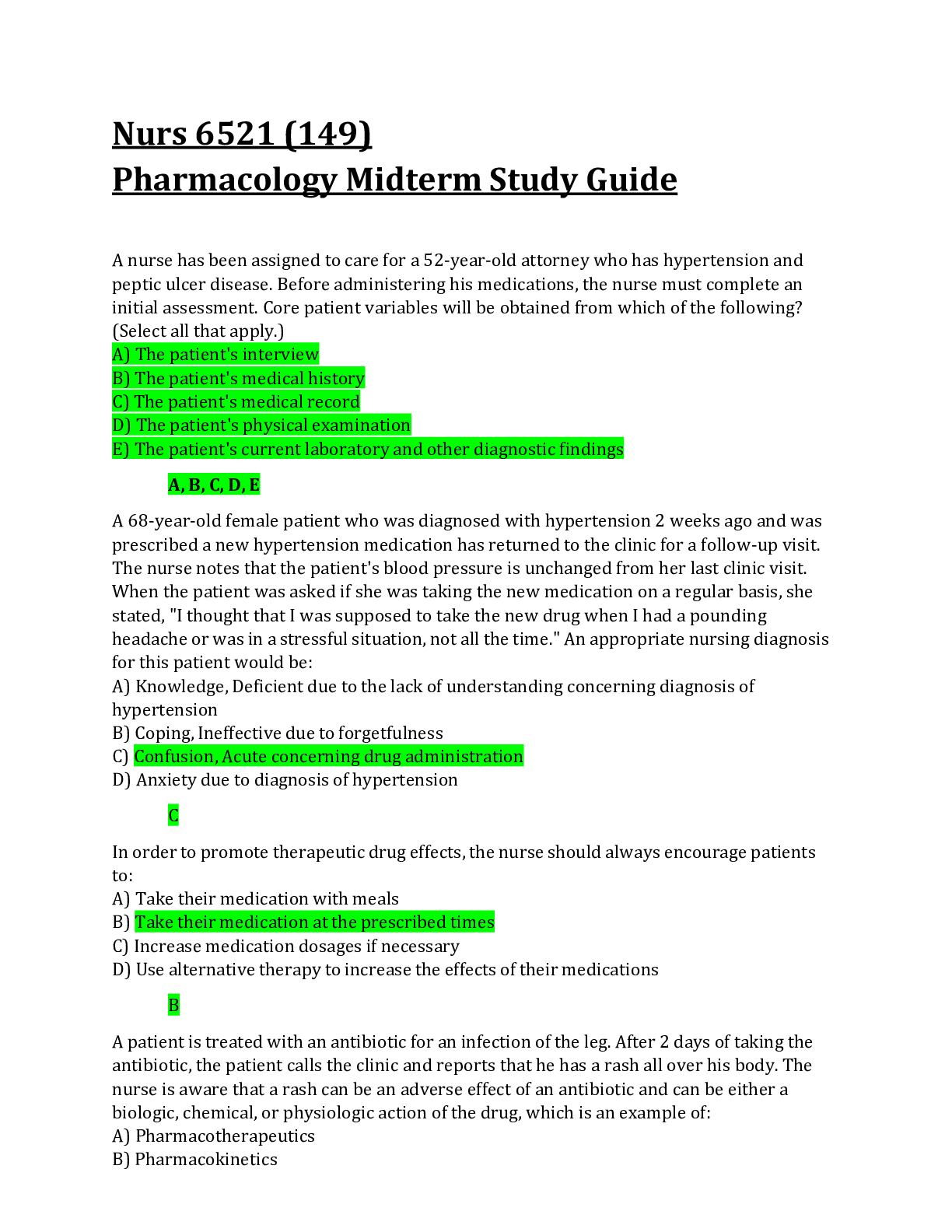*NURSING > EXAM REVIEW > NR 602 Midterm Study Guide (All)
NR 602 Midterm Study Guide
Document Content and Description Below
NR 602 Midterm Study Guide Topics 26-30: Cryptosporidium, Pyloric stenosis, Intussusception, Celiac Disease, & Juvenile Idiopathic Arthritis Cryptosporidium Cryptosporidium is a parasite. This is ... a living organism that live sin, or on, another organism. It can infect bowels and cause cryptosporidiosis. This is a form of bowel infection called Gastroenteritis, which leads to diarrhea and vomiting. In most healthy people, the infection produces a bout of watery diarrhea and will go away within a week or two. Immunocompromised patients…This can be a life -threatening disease. SSX: The first SSx usually appear within the week after infection Watery diarrhea Dehydration Lack of appetite Weight loss Stomach cramps Fever N/V Some people infected will have no symptoms. Preventing the spread with good hand hygiene, washing fruits and veggies, avoid fecal exposure, avoid contaminated water Symptoms usually resolve on their own Pyloric Stenosis Characterized by hypertrophied pyloric muscle, causing narrowing of the pyloric sphincter. Occurs in 3/1000 births Males >females Familial Common in first born Caucasian males Clinical findings: Regurgitation and NON projectile vomiting first few weeks of life PROJECTILE vomiting at 2 to 3 weeks old Insatiable appetite, with weight loss Dehydration, constipation Linked to erythromycin administration n first weeks of life PE: Weight loss Vomit that can contain blood A distinct “olive” mass that is often palpated in the epigastrium to the right of the midline Reverse peristalsis is seen Diagnostics US Upper GI series shows a “string sign” Management Surgery (Pyloromyotomy) after correction of fluid balance Prognosis is excellent Intussusception Thought to be the most frequent reason for intestinal obstruction in children Most commonly occurs in children 5 to 10 months of age Most common cause of intestinal obstruction in children 3 months to 6 yo 80% occur before age 2 Generally idiopathic in younger infants Sometimes in older children, underlying medical predisposing factors: polyps, Meckel diverticulum, constipation, lymphomas, lipomas, parasites, rotavirus, adenovirus, and foreign bodies. Can be a complication of CF. Clinical Findings Classic Triad: 1) intermittent colicky abdominal pain, 2) vomiting, 3) Bloody mucous stools Episodic abd pain with vomiting every 5 to 30 minutes Screaming and drawing legs up, with periods of calm or lethargy b/w episodes “currant jelly” stools Hx of URI common Lethargy PE Child may appear glassy-eyed in b/w episodes Sausage like mass may be felt in RUQ with emptiness in the RLQ (DANCE SIGN) Abd is distended and tender Guaiac + stools Diagnostics Abd flat plate can appear normalPlain x ray may show sparse or no intestinal gas or stool with air fluid levels and distention in small bowel only ABD US is very accurate in detecting intussusception and is TEST OF CHOICE SHOWS “TARGET SIGN” and the “PSEUDO KIDNEY” SIGN Management Emergency: needs pedi radiologist and pedi surgeon Rehydration, gastric decompression Radiologic reduction using air contrast enema under fluoroscopy is the gold standard Surgery is necessary if perforation, peritonitis IV antibiotics should be given Celiac Disease An immune mediated systemic disorder Triggered by dietary exposure to wheat gluten and related proteins in barley and rye Typical presentations occur between 6 months and 2 years old A complete dietary hx is needed: Past surgery Growth failure Delayed puberty can coexist Chronic diarrhea with frequent, large, foul-smelling, Pale stools Excessive gas with gas distention *Chronic or intermittent diarrhea, persistent or unexplained GI symptoms (N/V), weight loss, fatigue Impaired growth, FTT, Unexplained iron deficiency anemia, abd distention, bloating, cramping Tests Serologic testing (Gluten should be eaten more than one meal every day for 6 weeks prior to testing)…IgA tissue transglutaminase antibody (tTGA) and IgA endomysial antibody (EMA) If serology testing positive, refer for endoscopy with biopsy for definitive diagnosis Bone density testing (bone problems may the first symptom of celiac disease) Juvenile Idiopathic Arthritis (Page 551-554) Subtypes Oligoarticular: Characteristics: Four or less joints w/ persistent disease never having more than four-joint involvement and extended disease progressing to more than four joints within the first 6 months Polyarticular (RF negative): Five or more joints with symmetrical involvement Polyarticular (RF positive): Symmetric involvement of both small and large joints with erosive joint disease Systemic: Either polyarticular or oligoarticular disease Enthesitis-related arthritis: Weight bearing joints involved especially the hip and intertarsal joints and a hx of back pain, which is inflammatory in nature or sacroiliac joint involvement Psoriatic arthritis: Asymmetric or symmetric small or large joints Undifferentiated Diagnosis requires a persistent arthritis for more than 6 weeks in a pediatric pt younger than 16 years old. Underlying cause unclear Heterogenous disorder Likely environmentally induced in genetically predisposed individual Oligoarticular JIA is the most common subtype Affects Girls>Boys Clinical Findings Pain-generally a mild to moderate aching Joint stiffness-worse in the morning and after rest; arthralgia may occur during the day Joint effusion and warmth Systemic symptoms found more commonly in systemic and polyarticular subtypes: anemia, anorexia, fever, fatigue, lymphadenopathy, salmon-colored rash, weight loss, growth disturbances rheumatoid nodules PE: Key Findings: Swelling of the joint with effusion or thickening of synovial membrane Heat over the inflamed joint and tenderness along joint line Loss of ROM and function Uveitis and decreased vision Diagnostics: JIA is a diagnosis of exclusion; NO diagnostic lab test for JIA Useful tests include: CBC, ESR, CRP, Lyme titers, LFTs, ANA MRI can help in managing joint pathologic conditionsManagement Refer to pediatric rheumatology Ophthalmology referral if positive ANA Therapy depends on the severity of the disease Goal is to suppress inflammation, preserve and maximize joint function, prevent joint deformities, and maximize joint function, and prevent blindness *Page 552-553 goes more in depth on specific subtypes NSAIDS: Children w/ oligoarthritis generally respond well to NSAIDs Ibuprofen (greater than 6 months old) Tolmetin Naproxen Indomethacin (older than 2 years old) Celecoxib (Older than 2 yo) Oral, parenteral, intraarticular corticosteroids: Systemic Arthritis: Can be used for 2 weeks as initial therapy for SJIA w/ involvement of 4 or more joints All other types: Prednisone in lowest possible dose Intraarticular corticosteroid injections if severe Education Recommend yearly flu vaccine Instruct to keep appts with specialists Chronic disease counseling Physical therapy Water therapy Pain management Questions for Thought 1) The viral gastroenteritis seen in older children and adults has a short incubation (18-72 hours) and short incubation (24-48 hours), is characterized by abrupt onset of nausea and abdominal cramps, followed by vomiting and diarrhea, and is often accompanied by headache and myalgia. What causes this disorder? a) Enteric adenovirus b) Enteric calicivirus (Norwalk) c) Rotavirus d) CytomegalovirusAnswer: b Rationale: Gastroenteritis is a common cause of abdominal pain in children. Symptoms vary depending on the type of viral infection. Rotavirus mainly affects infants 3-15 months in the winter months, causing voluminous watery diarrhea w/out leukocytes. Enteric adenoviruses are the second most common viral infection in infants, with symptoms similar to rotavirus except the duration of the illness may be longer. Enteric calicivirus (Norwalk) mainly causes vomiting but also diarrhea in older children and adults. Duration of symptoms are short, usually 24-48 hrs. Cytomegalovirus rarely causes diarrhea. 2) The family nurse practitioner is interpreting the notation of “string sign” on an upper GI series performed on an infant. This is associated with the dx of: a) Intussusception b) Hirschsprung’s disease c) Pyloric stenosis d) GERD Answer: C Rationale: In book page 1102 3) An 18 -month old child is brought to the clinic by her mother and is c/o abrupt onset of vomiting, followed by more than 10 liquid stools with mucus for the past 48 hours. Temp is 100 degrees F orally. The stool smear obtained is negative for WBCs. What is the most likely etiologic pathogen for this young child’s gastroenteritis? a) Rotavirus b) Shigella dysenteriae c) Campylobacter jejuni d) Salmonella Answer: A Rationale: Rotavirus is the most frequent cause of gastroenteritis in children 6 months to 2 years of age. 4) What question by the FNP would be appropriate to ask the parents of an infant suspected of intussusception? a) “Does the infant have clay colored stools?” b) “Does the infant have projectile vomiting?” c) Does the infant have constant abdominal pain?” d) Does the infant have red currant jelly stools?” Answer: D Rationale: Red currant jelly stools are seen in intussusception and are caused by a mixture of stool, mucus and blood.5) A common cause of acute abdominal pain in children under 5 years old? a) Appendicitis b) Intussusception c) Incarcerated hernia d) Gastroenteritis Answer: D Rationale: Gastroenteritis is the most common cause of abdominal pain in all age groups 6) A 6 year old patient with sore throat has coryza, hoarseness, and diarrhea. What is the likely etiology? a) Group A Strep b) H. Parainfluenzae c) Viral etiology d) Mycoplasma Answer: C Hollier practice questions pg 455-456 7) A 14-year-old boy os brought In by his mother who reports that her son has been complaining for several months of recurrent bloating, stomach upset, and occasional lose stools. She reports that he has difficulty gaining weight and is short for his age. She ahs noticed that his symptoms are worse after eating large amounts of crackers, cookies, and breads. She denies seeing blood in the boy’s stool. Which of the following conditions is most likely? a) Amebiasis b) Malabsorption c) Chrohn’s colitis d) Celiac disease Answer: D 8) Which of the following findings could be expected to occur in a baby with intussusception? a) Inconsolable screaming b) Olive- shaped mass c) Left to right peristaltic waves d) Weight loss Answer: A 9) The most common rheumatoid disease of childhood is: a) Systemic lupus erythematosus b) Kawasaki disease c) Juvenile idiopathic arthritis d) Legg-Calve Perthes disease Answer: C10) Vomiting in infancy has a long list of differential diagnoses. Which accompanying symptom would likely point to pyloric stenosis? a) Diarrhea b) Appropriate growth c) Acts hungry after vomiting d) Sausage-shaped mass in abdomen Answer: C [Show More]
Last updated: 1 year ago
Preview 1 out of 8 pages

Buy this document to get the full access instantly
Instant Download Access after purchase
Add to cartInstant download
We Accept:

Reviews( 0 )
$6.00
Document information
Connected school, study & course
About the document
Uploaded On
May 15, 2021
Number of pages
8
Written in
Additional information
This document has been written for:
Uploaded
May 15, 2021
Downloads
0
Views
35

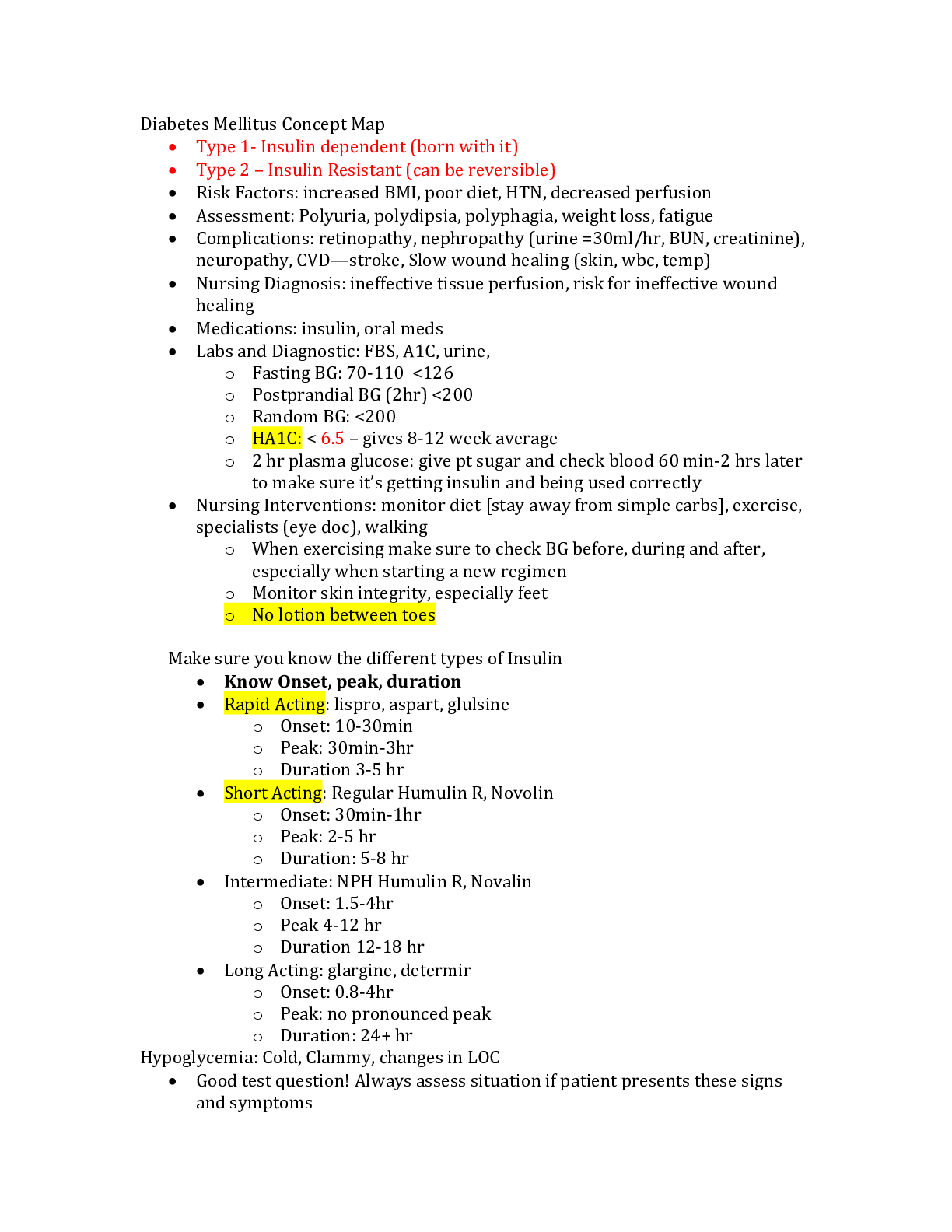
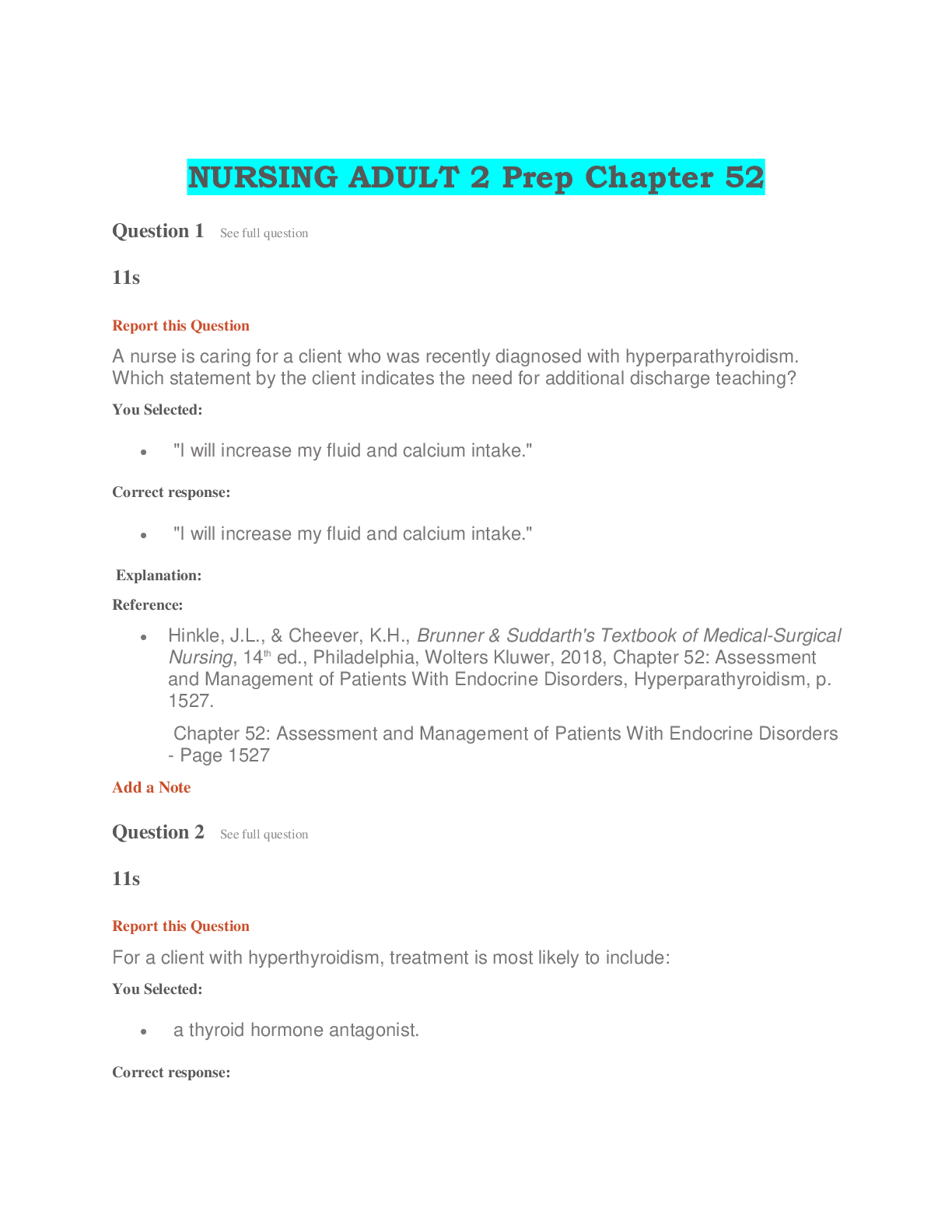
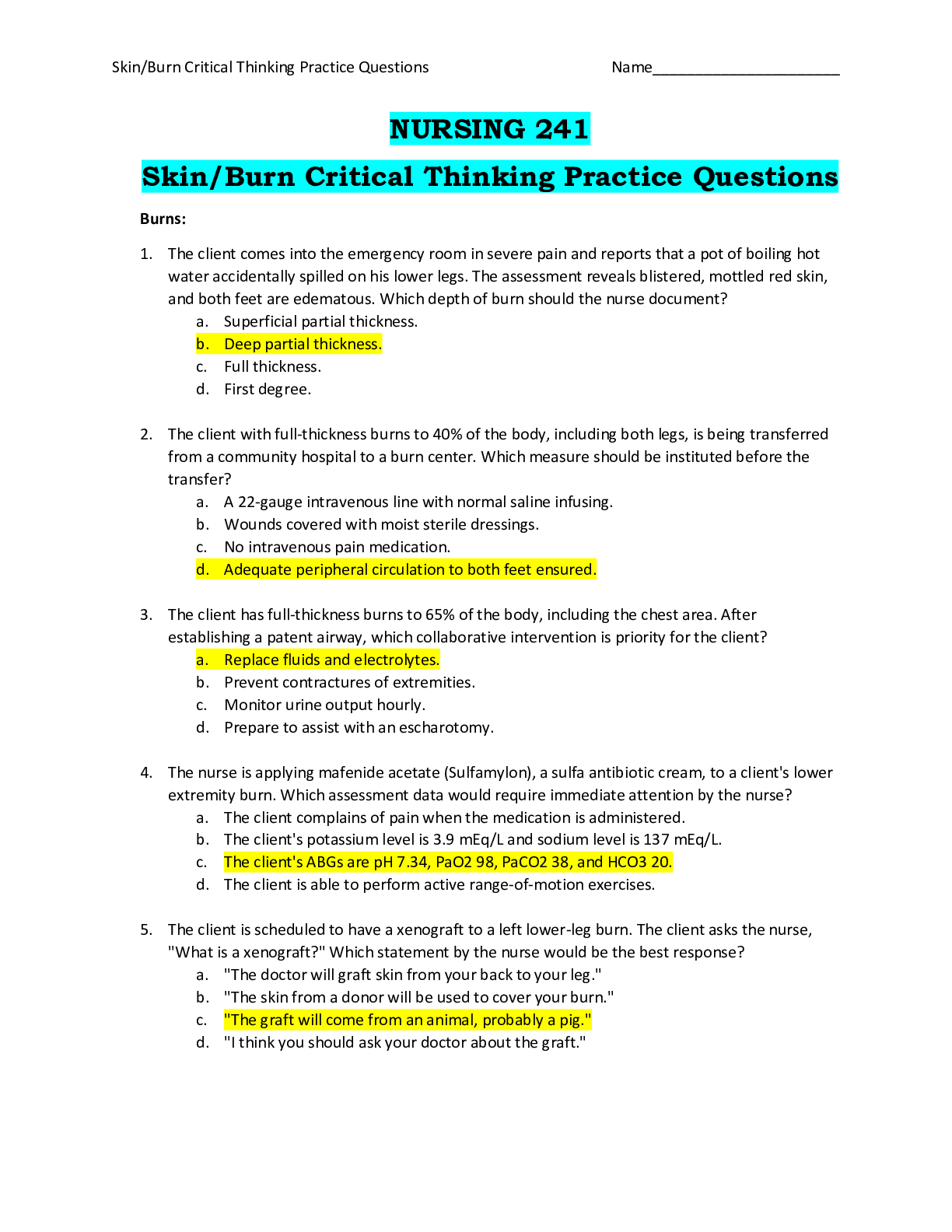
.png)
